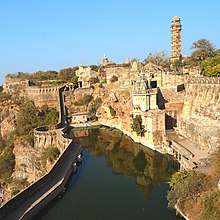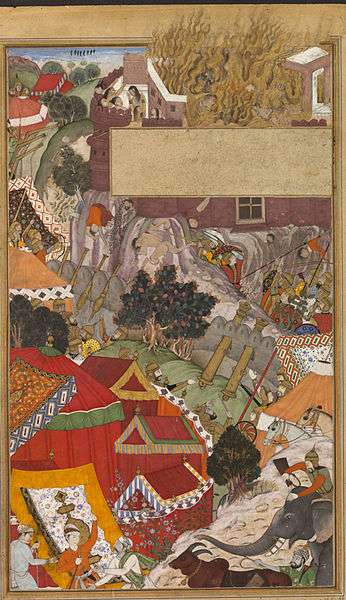Siege of Chittorgarh (1567–1568)
The Siege of Chittorgarh (20 October 1567 – 23 February 1568)[10] was a part of the campaign of the Mughal Empire against the kingdom of Mewar in 1567. Forces led by Akbar surrounded and besieged 8,000 Rajputs and around 40,000 peasants under the command of Jaimal in Chittorgarh.[11]
| Siege of Chittorgarh (1567–1568) | |||||||||
|---|---|---|---|---|---|---|---|---|---|
| Part of Mughal-Rajput War (1558-1576) | |||||||||
 Chittorgarh fort today | |||||||||
| |||||||||
| Belligerents | |||||||||
| Mughal Empire | Mewar | ||||||||
| Commanders and leaders | |||||||||
|
Akbar Todar Mal Bhagwant Das Abdul Majid Asaf Khan[1] Wazir Khan Mir Qasim Hussain Quli Khan}[2] Itmad Khan Syed Jamaluddin Barha |
Rao Jaimal † Patta Sisodia †[3][4] Aissar Das Chohan † rawat chundawat † Sanda Dodiya † Sahib Khan † Ismail † Kalla Rathore † | ||||||||
| Strength | |||||||||
| Thousands[5] |
7,000-8,000 men[6] 1,000 musketeers[7] | ||||||||
| Casualties and losses | |||||||||
| Unknown |
| ||||||||
The fortress
The history of the imposing fortress of Chittor is believed to date back to the 7th century. Known as Chitrakuta Durga, it is said to have been raised by Chitrangada of the Mori dynasty and then passed into the hands of the Pratiharas in the 9th century. Subsequent owners of this seat of power included the Paramaras (10th–11th century) and the Solankis (12 century) before it fell into the hands of the Guhilots or Sisodias of Mewar.[12]
The fort stands atop a 152m hill and covers an area of 700 acres (2.8 km2). It has a number of gateways and ponds including the Gaumukha kund and Hathi Kund, which is supplied by perennial underground source of water. Heavily fortified, Chittorgarh was believed to be insurmountable until it was sacked by Alauddin Khalji of the Delhi Sultanate in 1303. It was sacked again a couple of centuries later by Bahadur Shah of the Gujarat Sultanate.[12]
Background
The Mughals had always been wary of the kingdoms of Rajasthan. Besides being a centre of power, the Rajput dominions also hindered access to both Gujarat and its prosperous seaports as well as Malwa. To control either of these regions, the Mughal emperor also needed to arrive at an understanding with the Rajputs. Local rulers such as Raja Bharmal of Amber had already submitted to Akbar in 1562. Mewar, the most powerful and prominent of the Rajput states, however, had not. While Udai Singh, the Rana of Mewar was open to accepting Mughal suzerainty and paying a tribute, he was not prepared to lower his head in obedience to Akbar as, according to Abu'l-Fazl, "none of his ancestors had bowed down and kissed the ground". Furthermore, the Rana had also vexed Akbar when he first granted asylum to Baz Bahadur of Malwa and later, to the Mirzas of Sambhal.[13]
After handling the rebellions of the Mirzas and the Uzbek nobles in 1567, Akbar turned his eyes towards Rajasthan and its prestigious kingdom of Mewar.[14]
Prior to the siege, the Mughals under Asaf Khan and Wazir Khan attacked and conquered Mandalgarh, where Rawat Balvi solanki was defeated.[15]
On 20 October 1567, he encamped near the fortress of Chittorgarh. Maharana Udai Singh II had already retreated from the fortress of Chittorgarh and went to Gogunda, leaving behind 8,000 soldiers and 1,000 musketeers under the command of Jaimal and Patta. After arriving at Chittorgarh, Akbar sent Asaf Khan to Rampur and Hussain Quli Khan to Udaipur and Kumbalgarh to plunder the Rana's territories. Though both of these areas were raided, Udai Singh II was not found.[16]
The siege
Two armies raised their lances
They formed ambuscades, and drew up in line
They were all iron-fisted, biters of steel,
All were famous and were clad in iron
The heroes brandished swords red with blood
Initially, the Mughals tried to attack the fortress directly but the citadel was so sturdy that the only options available to the Mughals were to either starve out the occupants of the fort or to somehow reach the walls and sap beneath them.[11] After initial aggressive attempts at reaching the wall failed, Akbar ordered a complement of 5,000 expert builders, stonemasons, and carpenters to construct sabats (approach trenches) and mines to reach the walls.[11] Two mines and one sabat were constructed after significant casualties while three batteries bombarded the fort. A large siege cannon was also cast to breach the walls once the sabat reached the objective. The fort garrison which had been observing these preparations offered to surrender, and sent Sanda Silhadar and Sahib Khan to negotiate. They agreed to pay a yearly tribute and enroll in Akbar's court but were rebuffed by Akbar, who wanted Udai Singh himself to surrender.[8][18]
Fifty-eight days after the siege began, the imperial sappers finally reached the walls of Chittorgarh. The two mines were exploded and the walls were breached at the cost of 200 of the assault force. But the defenders soon sealed the opening. Akbar then steadily brought his siege cannon closer to the walls under the cover of the sabat. Finally, on the night of 22 February 1568, the Mughals were able to breach the walls at several locations simultaneously to begin a coordinated assault. In the ensuing battle, Akbar was able to kill the Rajput commander, Jaimal, with a musket shot. His death shattered the morale of the defenders who considered the day lost.[8]
Jauhar (self-immolation) was committed in the houses of Patta Sisodia, Aissar Das and Sahib Khan after the death of Jaimal. On 23 February 1568, Akbar personally entered Chittorgarh with a few thousand soldiers and it was conquered. The 1,000 musketeers escaped from the fortress.[19]
Rising pillars of smoke soon signalled the rite of jauhar as the Rajputs killed their families and prepared to die in a supreme sacrifice. In a day filled with hand-to-hand struggles until virtually all the defenders died. The Mughal troops slaughtered another 20-25,000 ordinary persons, inhabitants of the town and peasants from the surrounding area on the grounds that they had actively helped in the resistance.
Aftermath
Akbar stayed at Chittorgarh for three days before leaving for the shrine of Khwaja Moinuddin Chishti, as he had vowed to go to the shrine if he won the Siege. The other great fort at Ranthambor fell the next year and by conquering these two seemingly insurmountable symbols, Akbar had demonstrated the reality of Mughal might to all the other powers of North India.
However, Udai Singh II, the Rana of Mewar, continued to remain at large until his death four years later.[20] This was continued by his son Pratap Singh , who despite being defeated at the Battle of Haldighati and losing the entire Mewar until 1582, through guerilla warfare, managed to retain western Mewar until his death.[21] In 1615 Amar Singh I, the son of Pratap Singh accepted Mughal suzerainty and a year later Jahangir, as a goodwill gesture, allowed him entry in Chittor Fort under the condition that it will never be repaired, as it might be used a bastion for future rebellions.[22]
- Paintings depicting the siege
 The left panel of painting by Miskina (and Bhura) shows a mine exploding a section of the fortified wall of Chittorgarh and accidentally killing friendly forces.
The left panel of painting by Miskina (and Bhura) shows a mine exploding a section of the fortified wall of Chittorgarh and accidentally killing friendly forces. The right panel of the same composition by Miskina (and Sarwan) from the Akbarnama, c. 1590 – c. 1595.
The right panel of the same composition by Miskina (and Sarwan) from the Akbarnama, c. 1590 – c. 1595. Akbar, shoots the Rajput commander, Jaimal, using a matchlock, Akbarnama, 1590–1595.
Akbar, shoots the Rajput commander, Jaimal, using a matchlock, Akbarnama, 1590–1595. The jauhar of Rajput women at Chittorgarh, Akbarnama, 1590–1595.
The jauhar of Rajput women at Chittorgarh, Akbarnama, 1590–1595.
See also
Notes
- Akbarnama by Abu'l Fazl"The third battery was in charge of Khwaja Abdu-l-Majid Asaf Khan."
- Akbarnama by Abu'l Fazl" Ḥusain Qulī Khān was sent.....in accordance with the royal command, returned and was exalted by the bliss of doing homage."
- Maharana Pratap by Dr. Bhawan Singh Rana
- Akbarnama by Abu'l Fazl"he appeared to be one of the leaders....At last it came out that it was Patā who had been trampled to death."
- Akbarnama by Abu'l Fazl"Several thousand devoted men accompanied him on foot."
- Mughal Empire in India: A Systematic Study Including Source Material, Volume 1, pg.199, by S.R. Sharma
- Akbarnama by Abu'l Fazl
- Richards 1995, p. 26.
- Akbarnama by Abu'l Fazl"Nearly 30,000 men were killed."
- Akbarnama by Abu'l Fazl
- Chandra 2005, p. 107.
- ASI.
- Chandra 2005, pp. 106,107.
- Chandra 2005, p. 106.
- Akbarnama by Abu'l Fazl"Āṣaf Khān and Wazīr Khān.. went... with orders to attack the fortress of Māndal...It was...defended by...Rawat Balvī Solangī....but the conquered it."
- Akbarnama by Abu'l Fazl"Āṣaf Khān with a number of officers was sent off to Rāmpūr...Ḥusain Qulī Khān was sent with a large force to lay hold of him....Ḥusaīn Qulī Khān arrived at Udaipūr...the hill-country of Kombalmīr....made great search for the Rānā...could get no trace."
- Abu'l-Fazl. "PHI Persian Literature in Translation". persian.packhum.org.
- Akbarnama by Abu'l Fazl"they had recourse to craft and sent, firstly Sāndā Silāḥdār, and secondly, Ṣaḥib Khān, and made use of entreaties...offered to enrol themselves among the subjects of the sublime court, and to send a yearly present.... but the sovereign dignity did not accept this view, and made the coming in of the Rānā a condition of release from the siege."
- Akbarnama by Abu'l Fazl"One of the wonderful things was that the Shāhinshāh's wrath had been greatly excited against the skilful musketeers, but though much search was made no trace of them could be found.....by means of the disguise of trickery, carried off their lives in safety from the fort.
- Richards 1995, p. 27.
- Chandra 2005, pp. 121–122.
- Chandra 2006, p. 123.
References
- Sarkar, Jadunath (1994) [1984]. A History of Jaipur: c. 1503–1938. Orient Blackswan. ISBN 9788125003335: (completed by Sarkar in 1940)CS1 maint: ref=harv (link)
- Chandra, Satish (2005). Medieval India: From Sultanat to the Mughals Part - II (Revised ed.). Har-Anand Publications. ISBN 9788124110669.CS1 maint: ref=harv (link)
- Richards, John F. (1995) [1993]. The Mughal empire. New Cambridge history of India. 5. Cambridge University Press. ISBN 9780521566032.CS1 maint: ref=harv (link)
- "Chittaurgarh Fort". asi.nic.in. Archaeological Survey of India. Retrieved 28 July 2017.
External links
| Wikimedia Commons has media related to Siege of Chittorgarh. |
- Akbarnama by the Mughal-era historian Abu'l-Fazl